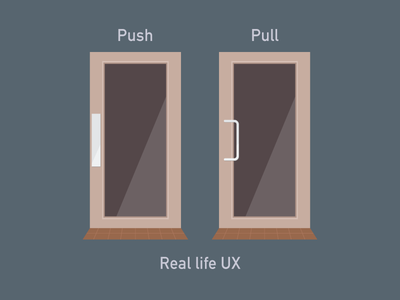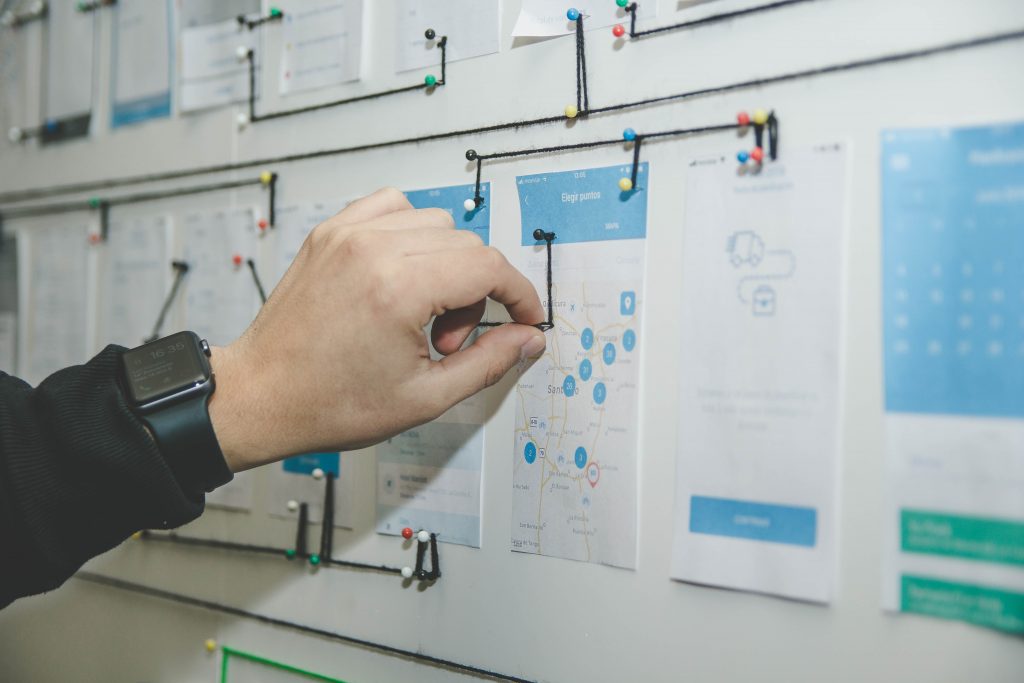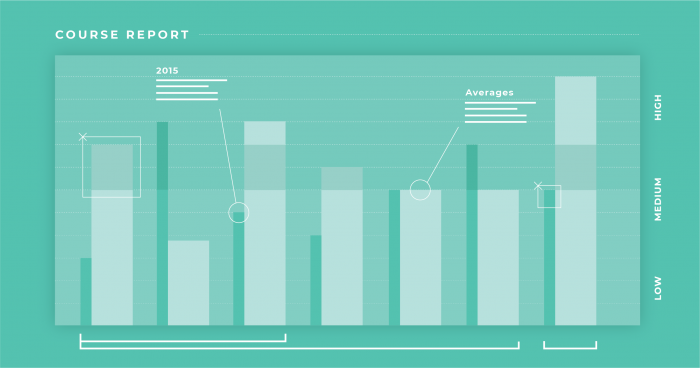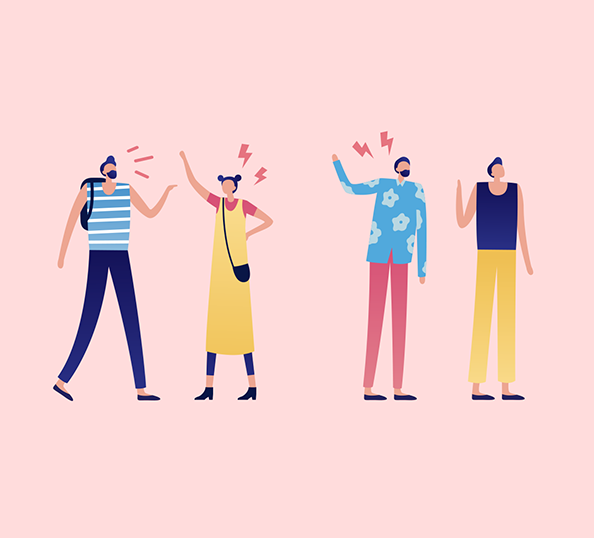UX design, or user-experience design, is the process of designing products or systems—usually digital ones—with the customer’s needs in mind. That might sound a bit vague and all-encompassing, and if it does, well, that’s kind of the point. UX considers the whole user journey.
When UX pioneer Don Norman invented the term in the 1990s, he did so with the intention of finding words to encompass the process of design: “I wanted to cover all aspects of the person’s experience with the system, including industrial design, graphics, the interface, the physical interaction, and the manual.” But user-experience can be applied to so many aspects of a product’s design and use that it can sometimes be hard to know what constitutes UX, and what makes it good.
As with other fields of design, good UX follows specific guidelines and principles—and always begins with a problem and tries to find the simplest solution to it. Take, for example, the intuitive way these doors communicate the direction of their swing and solve the age old push/pull conundrum.

But with so many different types of user experiences, how do UX designers develop systems that work across different products, platforms, and even language barriers? To begin, it helps to understand the core principles of good user experience design.
What is User Experience Design?
User experience (or UX) design is the process of creating meaningful and engaging experiences for users of a product or service. It fuses function, branding, design, usability, and empathy into a cohesive product with the end-user in mind.
User experience designers are not only concerned with how a product functions, but also how it makes people feel. Is it enjoyable? Does it evoke some emotion? Are the interactions satisfying? All of these factors work together to keep users engaged and using the product without frustrations and pain points. For many user experience designers, an excellent UX design system is defined as one that is “invisible”, a system that blends seamlessly into an intuitive user journey free from pain points or blockers. And those considerations extend from the digital world to the physical, across different operating systems and platforms, from a laptop or a phone to an espresso machine or ticket kiosk at an airport.
Why is User Experience Design Important?
Because experience matters, and customers who don’t have a good experience will soon leave for a better one. It’s impossible to retain and acquire new users unless your product is easy to use and accessible. For instance, a fast-loading website that adapts to different screen sizes (such as laptop screens and smartphone screens) with intuitive navigation and interface will retain more users than one that loads slowly and appears clunky on different screen sizes.
Examples of User Experience Design
Although user experience design in any situation is critical, it is always crucial to know the specific needs for different types of experiences. For example, a blog post requires far less UX consideration than that of a digital watch interface, though both require similar design systems. The more complexity there is, the more critical it is that its supported by a user-friendly design and architecture.
We highlighted some everyday situations or systems used by UX designers to create, test, or improve upon web experiences or digital products.
Digital Product Interfaces
Digital products—including online web experiences—are likely to have a strong UX design strategy because they are often a customer’s first and sometimes only experience with a product or brand. They need to anticipate and start solving a user’s problems from the first moment an individual interacts with their system, especially if the functionality of the product or service may not differ too much from that of a competitor.
Complex Inventory or Menu Systems
The more complex a system is, the more strategic your user-centered design approach needs to be, as something as seemingly simple as navigating back to the main menu can be a frustrating task. And a poorly considered UX system could hamper and even thwart a company’s success. A robust eCommerce website with thousands of products could quickly lose potential sales if users found it challenging to navigate to their shopping cart or find other relevant items. The user could abandon the site altogether and go to a competitor simply because of poor UX design.
The User Experience Design Process
There are numerous techniques involved in the user experience design process, and they can differentiate from one designer or company to another. However, some design process techniques are relatively common during the conceptualization and testing phase.

System Evaluation
A user experience designer sometimes needs to evaluate existing systems to determine the areas where upgrades would need to be done on the user experience. They will suggest fixes and plans for implementation based on their analysis and existing data. Systems can always be upgraded to create better experiences for users. It is common to see application and website upgrades solely to create a better experience.
A/B Testing
A/B testing is the process where a user experience designer tests different user experiences to determine the best one for implementation. During this process, the designer evaluates the experience of a design based on testing individual criteria, usually across several different sequences. These tests can include many different types of criteria, including how long users stay in a particular state, how many buttons are clicked, or which location on the screen a user clicks the most. Usually, these tests result in theories that drive final decisions. For example, if a blue button gets more clicks than a green button, the user experience designer will use that data to decide and prove that the blue button creates a better experience and will then use that as a defense to incorporate it in the final design.
User Testing
To a great extent, user experience is more subjective than it is objective. Each user of your system has different standards that they use to measure the user-friendliness of your system. Therefore, user tests and surveys can be an integral part of creating the best possible user experience for the broadest amount of users. During the user testing phase, both current and potential future users are interviewed to get their perspective on what they consider to be the most efficient design. Interacting with a range of users gives the user experience designer further insight and quantified data into what qualifies as the best user experience design.
Prototypes
Based on the preliminary research and testing, a user experience designer would create a prototype of what he feels is the best user experience architecture for a project. This prototype is generally a lookalike representation of how a product would look upon completion. However, the fidelity of the prototype—which can range from simple paper sketches to interactive digital experiences—is usually dependent on project needs and budget.
These prototypes serve to help the design team and other decision-makers to visualize how the final product would be and make any changes they feel is necessary before investing further into producing the actual product. Frequently, multiple iterations of prototypes are created before final decisions are made.

Design Patterns
Design patterns provide the user experience designer with the opportunity to pick the right design elements for the job that solve common design problems. Choosing the right tools leads to better choices in user experience design. user experience designers can also design custom patterns for projects to make a more unique and customized user experience. Websites, apps, and other projects all make use of design elements.
Content Inventory
A content inventory is a catalog of the content that a product or website contains. Carrying out a content inventory makes it easier for a user experience designer to make changes to the user experience from a high level. Through the content inventory schematic, changes could easily be made to the user flow and efficiency.
User Experience Design is Critical for Success
There are a number of various techniques used in the UX design process and they change from company to company, project to project. The main thing is to have a process at all and one that’s consistent, tested, and easy to replicate. We like Ideo’s process which addresses process from Inspiration to Ideation to Implementation, through the lens of empathy and usability.



